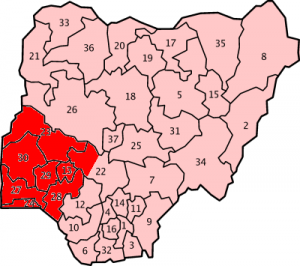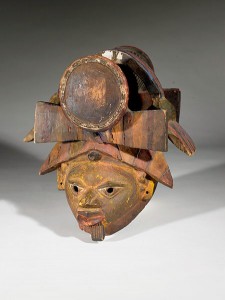The Yoruba

The Yoruba are one of the three major ethnic groups in Nigeria, concentrated in the south of the country. Archeological evidence suggests that the Yoruba have lived in the general area since prehistoric times. The Yoruba kingdom was of considerable power and importance and it was broken up through a series of wars for which the slave trade was partly responsible. The Yoruba people divided into numerous independent kingdoms that share an origin myth, but probably have never belonged to a political unit. The link that unites all Yorubas, even through the diaspora, is the honor of gods through the maintenance of history and religious traditions (“Cutting to the Essence-Shaping to the Fire”).
Gelede
Gelede, the masquerade performances of ancestral spirits, is associated with a deified founding foremother, either earth or water along with a forefather (Drewal 7). The Gelede honors and serves spiritually powerful women-elders, ancestors, and deities (Drewal 9). A woman’s status derives largely from her reputation in trading, her craftsmanship, and her wealth, rather than her husband’s importance. Since the principal occupation of Yoruba women is trading, many Gelede masks depict market women. These women are economically independent of their husbands and have the potential to earn even more money than the husband. Borrowing occurs, but with expectation that it will be paid back (Drewal 182).

Ideals such as patience, control and reverence are personified as women. “The mothers, who are united with all women by ‘the flow of blood,’ embody the concept of balance, a female quality that man must understand — indeed emulate — in order to survive” (Drewal 15). An elderly woman, her long years implying a secret knowledge and power may be regarded as a “witch” (Drewal 74). These elderly women and priestesses are often shown much affection. It is because of this special power that they have greater access to Yoruba deities. Elderly women whose longevity suggests a mystical power and a secretive knowledge are put into the same category as all those who hold important titles in cults for the gods and ancestors. Old age implies spiritual prowess taken from the end of menstruation (Drewal 74). Thus menopause plays a role in the community that, unlike in Western civilization, is very revered.
The Gelede masquerade consists of nighttime (Efe) and daytime (Gelede) performances, with different masks worn for each event. In the example here the masculinity of the Efe mask is represented in the flat, vertically striped, abstracted beard.
As a whole, Gelde celebrates womanhood and mothers. Yorubas claim that women possess the secret of life itself with both the powers to bring and remove life. The power of the mothers is equal to if not superior to that of the gods (Drewal 8). In these celebrations, masks known as Great Mothers are extremely revered and display respect for elderly women and priestesses.
See Gender and Nation, Third World and Third World Women
Works Cited
- Cutting to the Essence – Shaping to the Fire. (1995, March 29). History of Art Indiana University. Web. Mar 29, 1995.
<http://www.fa.indiana.edu/~conner/africart/home.html> - Drewal, Henry John and Margaret Thompson. Gelde: Art and Female Power among the Yoruba. Bloomington: Indiana University Press, 1983. 8-74.
Author: Melissa Creary, Fall 1997
Last edited: October 2017